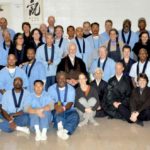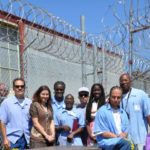Prior to the Volkswagen Bug, Frankfurter, Werner Klemperer and Beethoven, Germany bestowed upon mankind an icon of greater importance: The modern … [Read more...]
Archives for December 2012
Buddhist Practitioners Ordained in S.Q.
Eleven inmates and two free persons have been ordained as Buddhist lay practitioners in San Quentin. The San Quentin Buddhadharma Sangha conducted the … [Read more...]
Spending the Holiday Season in San Quentin
Little touches of the Christmas spirit are scattered around San Quentin. Twinkling lights and other decorations adorn the Protestant Chapel, Education … [Read more...]
Fallen War Heroes Honored on Veterans Day
As a bell tolled, San Quentin prisoners joined with community members to honor combat and suicide victims of the wars in Iraq and Afghanistan. The … [Read more...]
Green Life Celebrates its First Graduation
The earthly sound of a wood flute set the mood. The Green Life environmental program held its first graduation for 18 students and nine group … [Read more...]
Study: Innocent Often Pressured into Plea Bargains
Suspects who are falsely accused of committing crimes are often pressured into accepting plea bargains, according to a recent study. “It is unclear … [Read more...]
Symposium Brings Awareness to Restorative Justice
The healing power of dialogue was the theme for a symposium held recently at San Quentin’s Catholic Chapel. About 100 community members, and offenders … [Read more...]
Congressional Attention Focuses on Cost of Prison Phone Calls
Two congressmen are urging the Federal Communications Commission to act quickly to curb “exorbitant” costs when prison inmates telephone relatives and … [Read more...]
The Criminal Justice System in Peril from Potential Fiscal Cliff
Funding for state and local criminal justice programs are in jeopardy if Congress and the president do not come up with an agreement to reduce the … [Read more...]
Finding Redemption in Knowledge Behind Bars
While Michael Santos was waiting to be sentenced to a 45-year term for dealing drugs, he picked up a copy of Treasury of Philosophy and started … [Read more...]



